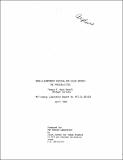Mobile-component housing and solar energy : the possibilities
Author(s)
Nutt-Powell, Thomas E.; Furlong, Michael
DownloadEL_TR_1980_023.pdf (2.928Mb)
Metadata
Show full item recordAbstract
This paper is part of a body of work directed at enhancing the acceptance of photovoltaics in various sectors of the U.S. economy. The focus here is on residential applications. The work is funded by the U.S. Department of Energy as part of its photovoltaics program. Earlier work has considered the nature of institutional forces in the housing sector generally, including a study of several housing developments incorporating solar thermal technologies with the assistance of the HUD-DOE Solar Heating and Cooling Demonstration Program. This earlier work resulted in a series of papers summarizing the application of institutional analysis methods to housing, including a research design (Nutt-Powell, 1979), and preliminary sector explorations covering housing production (Swetky and Nutt-Powell, 1979), governmental involvement in housing (McDaniel and Nutt-Powell, 1979), research and socialization in housing (Furlong and Nutt-Powell, 1979), energy provision in housing (Reamer, Heim and Nutt-Powell, 1979), and standards in housing (Parker and Nutt-Powell, 1979). The housing development case studies are reported in three papers (Nutt-Powell et al., 1979; Nutt-Powell, 1979b; Parker, 1980.) Additionally a separate analysis was undertaken of the HUD-DOE program, focused on implications for program design of PV acceptance in the housing sector (Nutt-Powell, 1980). This analytic work has paralleled and contributed to development of specific approaches to residential acceptance, including a Residential Application Implementation Plan (MIT EL/LL, 1979). The various studies and plans completed to date have taken a very broad view of the housing sector. As the technology develops, coming closer to cost and production feasibility on a large scale, it is appropriate to begin more detailed analyses of the housing sector. Among such detailed analyses are those considering the possibilities for acceptance of PV among different modes of housing construction. This paper is one such analysis. The focus is on that form of housing production defined as "mobile-component housing," a type of housing built in a factory to a single national construction standard administered by the U.S. Department of Housing and Urban Development. There are four sections in this paper. The first section describes the structure of the manufactured housing industry. It provides definitions and terminology necessary to a discussion of mobile-component housing. It then reviews the production activity and approach, distribution, consumer and financing for this mode of housing. The second section presents the product characteristics of mobile-component housing. The third section reviews solar technologies, and discusses their relation to mobile-component housing. The fourth section focuses specifically on factors influencing receptivity to solar by the mobile-component housing industry. The conclusion to this paper summarizes the analysis as it relates to the possibilities for photovoltaics in mobile-component housing.
Date issued
1980Publisher
Cambridge : Massachusetts Institute of Technology, Energy Laboratory, 1980
Series/Report no.
Energy Laboratory report (Massachusetts Institute of Technology. Energy Laboratory) no. MIT-EL 80-023.
Keywords
Mobile homes., Solar energy., Photovoltaic power generation.